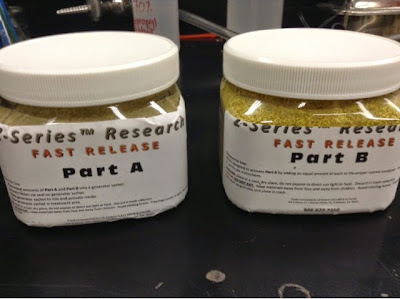Counted CFU on P. larvae spore plates:
| Spore Stock | 10^-2 | ||||
| D | 1 | 3 | 4 | 1 | 2 |
| E | 3 | 1 | 3 | 2 | 1 |
| F | 0 | 1 | 1 | 0 | 1 |
| G | 5 | 8 | 3 | 5 | 6 |
| H | 7 | 5 | 10 | 9 | 11 |
| I | 3 | 4 | 2 | 3 | 4 |
| J | 2 | 1 | 1 | 0 | 1 |
| Spore Stock | 10^-1 | ||||
| C | 2 | 3 | 2 | 1 | 2 |
Equation used to calculate concentration of Spore Stocks:
[AVG # colonies counted / volume pipetted onto plate in uL] * [ 1 / serial dilution made (ie 10^-2)] * [1000 uL / 1 mL] = CFU/mL
Concentration:
Stock C = 2,000 CFU/mL
Stock D = 55,000 CFU/mL
Stock E = 20,000 CFU/mL
Stock F = 6,000 CFU/mL
Stock G = 54,000 CFU/mL
Stock H = 84,000 CFU/mL
Stock I = 32,000 CFU/mL
Stock J = 10,000 CFU/mL
(Stocks are in a 500 uL volume of H2O)
Followed procedure on 10-28-14.
Goal: Determine if chlorine dioxide gas is able to kill P. larvae spores at any concatenation. For this study, a high and low concentration of chlorine dioxide gas will be exposed to spores on glass cover slips for a period of time. After exposure, CFU will be determined via plate counts. This is an important preliminary step to determine the efficacy of chlorine dioxide gas as a sterilization agent of P. larvae spores.
Re-concentrated spore stocks H and I by pelleting them and re-suspending at 200 uL H2O. Sterile glass cover slips were inoculated with 50 uL of spore stocks (volume was placed on the center of the square glass cover slip) and were allowed to dry for about an hour in the fume hood.
Reagents for Chlorine Dioxide gas, Part A and Part B as seen below, were weighed out using the balance in the Pruess Lab. Two different concentrations were weighed out: 50 mg and 5 mg of each reagent. The reagents will be mixed 1:1 to generate the gas in a 50 mL conical tube. For example, 50 mg of Part A will be mixed with 50 mg of Part B, with a final concentration of 100 mg of reagent.
After the two chlorine dioxide reagents were combined in the 50 mL conical tubes the glass cover slips containing the dried spores were quickly and aseptically transferred to 50 mL tubes (image below). Note: be careful that the ClO2 regents are at the bottom of the tube to ensure better interactions with each other and to generate gas more efficiently.
Reagents for Chlorine Dioxide gas, Part A and Part B as seen below, were weighed out using the balance in the Pruess Lab. Two different concentrations were weighed out: 50 mg and 5 mg of each reagent. The reagents will be mixed 1:1 to generate the gas in a 50 mL conical tube. For example, 50 mg of Part A will be mixed with 50 mg of Part B, with a final concentration of 100 mg of reagent.
 |
| ClO2 reagents |
 |
| Glass cover slip in 50 mL conical tube |
The tubes were sealed with parafilm and transferred to a shaker incubator protected from light. Temperature was set to room temp (not on) and tubes were gently shaken for six hours. It is important that the tubes are protected from direct light as much as possible once the reagents were mixed as the light can dissociate the gas. It is also important to rotate the tubes in an attempt to better mix the gas.
After six hours, the glass cover slips were aseptically transferred to a new 50 mL tube containing 1 mL of ddH2O. The idea is to re-suspend the spores present on the glass cover slip in the H2O. The glass cover slips were broken with forceps each time and vortexed for 30 seconds. Tubes incubated at room temperature for 5 minutes. 10 uL volumes of the tube culture was plated onto MYPGP agar for CFU counts. Cultures were also diluted 1:2 and 10 uL volumes also plated.
Plates were incubated at 37C for three days until colonies are visible and are able to be counted.
//EWW
No comments:
Post a Comment